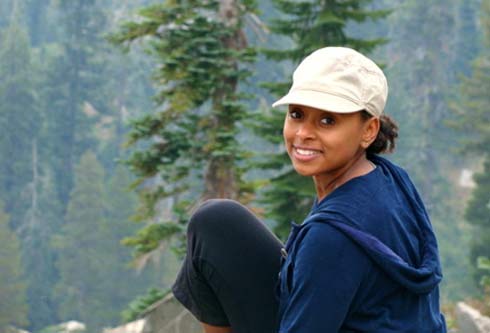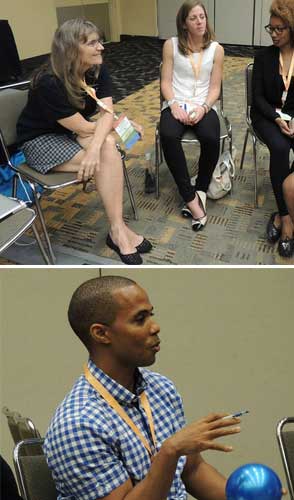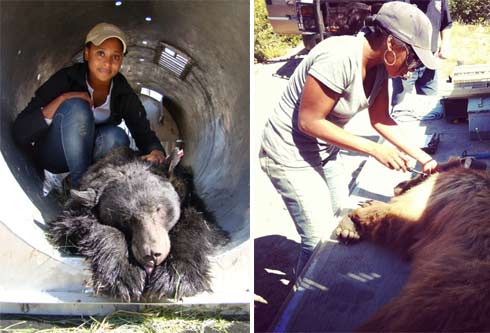 |
|
SCB Diversity Committee member Rae Wynn-Grant in the Sierra Nevada Mountain Range |
At ICCB 2013 in Baltimore, Maryland, then SCB President Rodrigo Medellín made a motion to establish an ad hoc committee on diversity and membership. Rodrigo, the Society’s first president from a developing country, wanted SCB to do more to diversify its membership, and to engage the broader community of conservation students and professionals in SCB activities.
 |
|
SCB Diversity Committee co-chairs Leo Douglas, bottom, and Eleanor Sterling, top left at a diversity committee workshop at ICCB 2013 in Baltimore, Maryland, USA. |
The committee has initiated several activities, including surveys of SCB leadership on social diversity and other professional societies on diversity activities and has convened workshops, roundtables, and plenary talks on diversity at SCB meetings. In July 2015, the SCB Board of Governors changed the status of the Diversity Committee from ad hoc to standing following a presentation on the results of the committee's work by Cynthia Malone, a founding member of the Diversity Committee and its Vice Chair.
Under the direction of co-chairs Eleanor Sterling and Leo Douglas, the Diversity Committee will work with the SCB to formally implement strategies that will increase diversity within SCB and the broader conservation community.
Committee member Dr. Rae Wynn-Grant will play a key role in helping the committee achieve its goals. Wynn-Grant is a postdoctoral fellow at the Center for Biodiversity and Conservation at the American Museum of Natural History where she works on the impact of human activity on black bears and management applications to reduce human-wildlife conflict.
 |
|
Diversity Committee Vice Chair Cynthia Malone presents the results of the committee's preliminary scan of diversity across environmental societies at a workshop entitled "Paths Towards a Broader Conservation Community" at ICCB-ECCB. Cynthia has co-lead the development and coordination of the committee's strategic planning, communications, and ongoing projects. |
On Bears and Humans, an article published in Columbia’s Superscript, profiles Wynn-Grant’s work and describes how the PBS television shows that inspired her love of nature as a kid also contributed to a perception that conservation was not a vocation for people of color. She hopes that her work with the Diversity Committee and beyond will support a new perception that conservation is a field with room for everyone.
Following is a Q&A with Wynn-Grant that addresses her interest in diversity in conservation and challenges to improving diversity and inclusiveness in conservation.
Broadly speaking, how would you describe the state of human diversity in conservation?
There are people all over the world who are involved in different aspects of conservation. However, the majority of conservation scientists are from the western world and overwhelmingly white. This is especially the case if you look at what types of people make up conservation organizations and academic departments.
What are some challenges facing the field when it comes to improving diversity and inclusiveness?
It can be a challenge to figure out where to start. For example, we can't just recruit people of color into conservation organizations - we have to make sure people of color are in the pipeline from early on, namely from high school or college. As well, conservation organizations and institutions need to be an attractive place for people of color. It needs to be clear that diversity is welcomed and diverse perspectives and backgrounds are celebrated.
 |
|
Rae Wynn-Grant tags a tranquilized black bear in Nevada |
In what ways has your experience as a black woman working in conservation shaped how you think about diversity in conservation?
I have often felt extremely isolated, both as a result of the kind of field work I do, and also as a result of often being one of few or the only black person at conferences or meetings or in academic departments. During trying times, the isolation has made me want to quit conservation and go into another line of work. In other circumstances, it has made me dedicated to doing as much as I can to make the field of conservation more diverse and inclusive by communicating my own work, reaching out to underrepresented groups, and serving as an example of what a conservation scientist can look like.
When you survey the field of conservation, what discourages you the most when it comes to attaining a more inclusive, diverse community of conservation?
When I first began studying conservation science, I was extremely discouraged by the fairly imperialistic tactics that were still being employed in areas of conservation concern in the developing world. I still think one of our main goals should be to promote the management of natural resources by local and indigenous people while also achieving conservation success. I'm happy that I now know many people, projects, and organizations that have a similar vision. In this way, we should see lots of capacity building globally and a more diverse conservation science force.
 |
|
Rae Wynn-Grant at Columbia University where she earned her PhD |
What have you seen that encourages you the most about making progress in diversifying the conservation community?
By dedicating myself to increasing diversity in conservation, I have had the privilege of meeting conservation scientists of many racial and ethnic groups and nationalities. It's extremely encouraging to know that we're not starting from zero, and that despite diversity being a challenge, there are many like-minded individuals who consider it a priority for conservation to be successful.
Careers in conservation cross multiple sectors, from government and NGOs to higher education and private sector consulting and contract work. Is there a noticeable variance of workforce diversity between these sectors?
In general, my experience is that all of these sectors are similar in that the racial and ethnic diversity is extremely low. Across the board, we find that the most racial diversity is found in support staff, but not in the group of scientists and managers directly working on conservation issues. In general, we will benefit from having diverse perspectives and experiences at the decision-making table.
Are there any particularly challenging obstacles to attaining more diversity in conservation?
Many scientists are challenged with effectively communicating their work to the public, making it difficult for people to understand the issues scientists are tackling. Unless you have some kind of exposure to conservation at a young age, it can essentially be a bit of a hidden field of study, preventing many people from pursuing it as a career. This was the case with me - I loved nature shows on TV as a kid, but had no idea that I could have a job working with wildlife. This adds to our lack of diversity in the field. We as conservation scientists need to put effort into communicating our science to the public in an engaging and effective way, whether that's through media or education or advocacy.
 |
|
Wynn-Grant in the field working with tranquilized black bears. |
If you could get people to understand one thing about the value of diversity, what would it be and why?
There have been studies that show that diverse groups of people are better able to solve complex problems than homogenous groups of people trying to solve the same problem. This is a crucial point for conservation, as we are all working towards the same, extremely important goals that impact the world. If we can do a better job of meeting our conservation objectives when we have a beautifully diverse group of scientists working together, the act of diversifying should be top priority!
Do you have anything else to add?
The Diversity Committee needs more members and more support! We look forward to including more SCB members in our group and having more participation in our upcoming seminars and workshops at the 2016 conferences.
Contact the Diversity Committee to learn how you can help contribute to the Society's goals of greater diversity and inclusiveness in conservation.